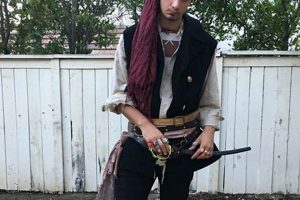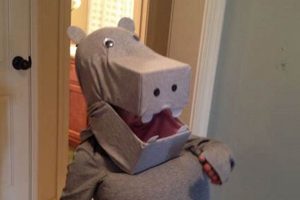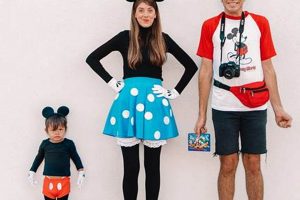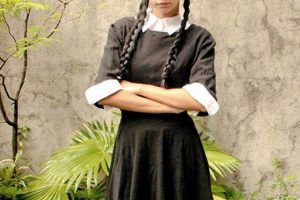Creating homemade attire replicating the characters Thing One and Thing Two from Dr. Seusss The Cat in the Hat typically involves crafting red jumpsuits and attaching circular white patches labeled Thing 1 and Thing 2. Variations in execution might include using felt, fabric paint, or iron-on transfers for the labels, and different materials for the jumpsuits, such as fleece or cotton, depending on desired comfort and durability.
Producing these costumes offers several advantages. It presents a cost-effective alternative to purchasing pre-made versions. The activity allows for personalization and customization reflecting individual preferences and available resources. Furthermore, the construction process can be a collaborative and engaging activity for families or groups, fostering creativity and resourcefulness. The concept has seen consistent popularity, linked to the enduring appeal of the original story and its characters, making it a frequently chosen option for themed events, literary celebrations, and Halloween festivities.
Subsequent discussion will address the selection of appropriate materials, step-by-step construction methodologies, and various embellishment options for achieving desired aesthetic outcomes. Specific attention will be given to creating the distinctive blue hair characteristic of the characters, offering multiple approaches to suit differing skill levels and budgetary constraints.
Essential Guidance for Thing One and Thing Two Costume Creation
The following guidelines offer practical advice for successful homemade Thing One and Thing Two costumes, ensuring both accurate representation and long-lasting wear. Consideration of these points will improve the final result.
Tip 1: Fabric Selection: Prioritize breathable, durable materials for the jumpsuit base. Cotton or cotton blends offer comfort, while fleece provides warmth for cooler climates. Avoid excessively sheer or delicate fabrics that may require additional lining.
Tip 2: Precise Measurement: Accurate measurement is critical for a well-fitting costume. Take body measurements prior to pattern selection or cutting fabric. Add seam allowances generously to allow for adjustments during construction.
Tip 3: Label Consistency: Ensure that the circular white patches are consistently sized and positioned on both Thing One and Thing Two costumes. Templates or stencils can assist in maintaining uniformity during the application of the “Thing 1” and “Thing 2” labels.
Tip 4: Secure Attachment: Utilize robust adhesives or stitching techniques to firmly affix the labels to the jumpsuits. Iron-on transfers should be properly applied according to manufacturer instructions, and reinforced with stitching for added security.
Tip 5: Blue Hair Alternatives: Consider multiple methods for creating the characteristic blue hair. Options range from commercially available wigs to yarn, felt, or even painted foam, each offering varying levels of realism and comfort. A trial run of the selected method is advisable.
Tip 6: Avoiding Irritants: Pay attention to ensure materials chosen are not irritants to the skin. Thoroughly wash any new fabric to remove dyes or chemicals.
Adherence to these guidelines will enhance the quality, durability, and comfort of homemade Thing One and Thing Two costumes. Thoughtful planning and careful execution contribute to a successful outcome.
The concluding section will examine common pitfalls to avoid during construction and provide resources for further inspiration.
1. Fabric selection
Fabric selection is a primary determinant of the overall quality, comfort, and durability of homemade Thing One and Thing Two costumes. The choice of material directly affects the wearer’s experience, influencing factors such as breathability, range of motion, and potential for skin irritation. For instance, using a heavy, non-breathable fabric like vinyl may result in overheating and discomfort, particularly for children wearing the costume for extended periods. Conversely, a lightweight, breathable cotton fabric may be more comfortable but may lack the desired structure or durability for repeated use. Therefore, careful consideration of the intended use and the wearer’s needs is paramount when choosing fabrics for these costumes.
Practical application of appropriate fabric selection involves balancing desired characteristics with cost constraints. For instance, fleece offers warmth and a soft texture, making it suitable for colder climates, but it may be more expensive than simpler cotton alternatives. Similarly, stretch fabrics, such as spandex blends, allow for greater freedom of movement, which is advantageous for active children, but they can be more challenging to sew and may require specialized equipment. Example: If the costume will be used primarily for indoor events, a mid-weight cotton or poly-cotton blend may be sufficient, while outdoor use necessitates more robust and weather-resistant materials. To that end, the use of felt may be more adequate for indoor event as well, given that it allows the costume to be more flexible.
In summary, optimal fabric selection for constructing Thing One and Thing Two costumes involves a careful assessment of intended use, wearer comfort, and budget. Selecting the right material impacts the costume’s visual appeal, its functionality, and its longevity. Therefore, paying close attention to fabric properties and intended application is crucial for achieving a successful and satisfying outcome. A main challenge would be to satisfy all requirements, such as balancing durability with comfort, while staying within budget.
2. Pattern Accuracy
Pattern accuracy constitutes a foundational element in the successful execution of homemade Thing One and Thing Two costumes. Deviations from precise pattern dimensions and shapes directly impact the costume’s fit, appearance, and overall resemblance to the characters. For example, an inaccurately sized jumpsuit pattern can result in a costume that is either too restrictive, inhibiting movement, or excessively large, compromising visual appeal. Similarly, imprecise pattern shapes for the circular patches or blue hair elements can lead to a distorted or unprofessional final product. Real-world instances demonstrate the effects of pattern accuracy: poorly executed patterns lead to costume asymmetry, incorrect proportions, and an overall diminished representation of the intended characters. Thus, pattern accuracy is more than just a technical consideration; it is a critical factor in achieving recognizable and aesthetically pleasing results.
The practical significance of pattern accuracy extends beyond visual fidelity. A precisely executed pattern facilitates a smoother and more efficient construction process. Accurate pattern pieces align correctly, reducing the nee
d for extensive alterations and adjustments during sewing. This is particularly important for those with limited sewing experience. Access to reliable patterns, whether commercially sourced or meticulously drafted, becomes indispensable. Several online resources and tutorials provide patterns for Thing One and Thing Two costumes, but their accuracy varies considerably. Careful review and verification of pattern dimensions against standard sizing charts are essential. Additionally, the use of muslin or other inexpensive fabric for creating a test garment, or toile, allows for pattern adjustments prior to cutting the final costume material, minimizing costly errors and material waste.
In conclusion, pattern accuracy is inextricably linked to the overall success of homemade Thing One and Thing Two costumes. The effects of accurate dimensions range from improved aesthetics and fit to streamlined construction and reduced material waste. Addressing challenges in pattern selection and validation ensures a more satisfying and professional-looking final product. Furthering one’s understanding of the correlation and effects of Pattern Accuracy will enhance the final result of creating said project. Thus, emphasizing the importance of pattern accuracy in creating quality results.
3. Label application
The affixation of labels constitutes a critical step in the creation of Thing One and Thing Two costumes. These labels, typically circular patches bearing the text “Thing 1” and “Thing 2” respectively, are central to the character recognition and aesthetic of the costumes. The method and quality of their application directly impact the overall appearance and durability of the finished product.
- Adhesive Selection
The choice of adhesive method, encompassing options such as fabric glue, iron-on transfers, or direct stitching, impacts the longevity and aesthetic appeal of the label application. Fabric glue provides a quick and straightforward solution but may be prone to peeling or detachment with repeated washing. Iron-on transfers offer a more secure bond but require careful application to prevent scorching or bubbling of the fabric. Direct stitching, while more labor-intensive, provides the most durable and professional finish. The selected adhesive method should be compatible with both the label material and the costume fabric, preventing damage or discoloration. The wrong adhesive can also create safety hazards for children.
- Placement Precision
Accurate placement of the labels on the costume is crucial for maintaining the visual integrity of the characters. Deviation from the established placement, typically centered on the torso, can result in a distorted or unbalanced appearance. The use of templates or measuring tools aids in ensuring consistent and symmetrical placement across multiple costumes, particularly when creating costumes for groups or families. The final costume label location will have an impact on how the costume wearer’s body looks.
- Material Compatibility
Label material selection plays a significant role in the overall effectiveness of the application. Felt, fabric, or pre-printed iron-on transfers are common choices. The chosen material must be compatible with the chosen adhesive method and the base fabric of the costume. For instance, using a heavy felt label with a lightweight fabric glue may result in inadequate adhesion, while using an iron-on transfer on a heat-sensitive fabric may cause damage. The proper label thickness and label material will have an impact on how the costume looks. Furthermore, materials chosen should ensure children with sensitive skin are protected from allergies.
- Durability Considerations
The durability of the label application is paramount, particularly for costumes intended for repeated use or washing. Reinforcement techniques, such as stitching around the perimeter of glued or ironed-on labels, can significantly extend the lifespan of the application. Selecting high-quality adhesives and fabrics that are resistant to fading, cracking, or peeling ensures that the labels remain securely attached and visually appealing over time. The location of the label must also allow for comfortable movement and must not be exposed to potential hazards that can damage the label or cause it to rip. The final result label durability will make the costume last for a long time.
These facets highlight the intricate relationship between label application and the overall success of homemade Thing One and Thing Two costumes. The selection of appropriate materials, precise placement, and durable application techniques are essential for achieving a professional-looking and long-lasting result, all of which add a visual appeal to the final product.
4. Hair construction
Hair construction is a crucial element in realizing authentic Thing One and Thing Two costumes. The characteristic bright blue, spiky hairstyle is instantly recognizable and significantly contributes to the overall impact and success of the costume. The selection of materials and methods employed directly affects the visual accuracy, comfort, and durability of this component.
- Material Selection for Volume and Shape
Achieving the required volume and shape often involves selecting materials such as felt, yarn, tulle, or commercially available wigs. Each material offers different properties affecting the overall look and feel. For example, felt provides structure but can be less comfortable against the skin. Yarn offers a softer texture but may require more effort to achieve the desired shape. The chosen material must balance visual accuracy with wearer comfort, especially for children.
- Spike Formation Techniques
Creating the signature spiky appearance necessitates specific construction techniques. These might include cutting and shaping felt into individual spikes, wrapping yarn around cones, or styling a wig with hairspray. The technique employed dictates the level of realism and effort required. Inadequate spike formation can result in a flattened or misshapen hairstyle, diminishing the costume’s impact. Conversely, meticulous attention to detail enhances the resemblance to the characters.
- Attachment Methods for Security and Comfort
Securely attaching the constructed hair to a headband, hat, or directly to the head is vital for maintaining the costume’s integrity. Attachment methods can include gluing, sewing, or using hook-and-loop fasteners. The chosen method must be robust enough to withstand movement and activity while remaining comfortable for the wearer. Improper attachment can lead to the hair piece detaching during wear or causing discomfort and irritation.
- Color Accuracy and Vibrancy
The vibrant blue color of the hair is a defining feature of Thing One and Thing Two. Achieving accurate color representation requires careful selection of dyes, paints, or pre-colored materials. Fading or inaccurate color shades detract from the overall effect. Using high-quality, colorfast materials ensures the hair maintains its vibrancy over time, particularly after washing or exposure to sunlight.
The facets of hair construction underscore the importance of meticulous planning and execution in the creation of Thing One and Thing Two costumes. Effective material selection, spike f
ormation techniques, secure attachment methods, and accurate color representation contribute significantly to the success and recognizability of the final product. Prioritizing these elements enhances the visual impact and overall quality of the costumes. Consider the cost and time implications of each of these steps.
5. Comfort considerations
The intersection of comfort considerations and creating Thing One and Thing Two costumes hinges on wearability, particularly given that these costumes are often worn by children for extended periods. Costume design choices directly impact the wearer’s physical experience. Materials that lack breathability, such as non-porous synthetic fabrics, can cause overheating and discomfort. Ill-fitting garments, regardless of the materials used, restrict movement and lead to chafing or irritation. In the creation of homemade Thing One and Thing Two costumes, prioritizing comfort directly affects the wearer’s willingness to engage fully in activities while costumed.
Practical application of these comfort considerations involves several key decisions during the design and construction phases. Fabric selection is paramount; natural fibers such as cotton or linen, or moisture-wicking synthetics, promote breathability and reduce the risk of overheating. Seam placement should minimize potential friction points, and alterations may be necessary to ensure a comfortable fit that allows for a full range of motion. For example, a costume with a tight neckline or constricting armholes will inevitably lead to discomfort and reduced wear time. Furthermore, incorporating features such as adjustable closures or elastic waistbands can improve the overall fit and adaptability of the costume. Real-world observation shows many children’s Halloween costumes are quickly discarded due to scratchy fabrics, poor fit, or overheating; a homemade option, with attention to comfort, has the potential to remedy these issues.
In summary, attending to comfort is integral to the successful creation of Thing One and Thing Two costumes. Fabric choices, fit, and construction techniques directly impact the wearer’s physical experience. Overlooking these aspects leads to discomfort and limited wearability. By prioritizing comfort, the homemade Thing One and Thing Two costumes become more enjoyable, promoting creativity, and allowing the wearer to fully participate in themed events. The initial consideration will be to evaluate a cost plan that includes comfortable, breathable fabrics. Challenges may arise in balancing the demands of visual accuracy with practical comfort requirements, but thoughtful design can overcome these limitations.
6. Durability enhancement
Durability enhancement, within the context of homemade Thing One and Thing Two costumes, refers to the implementation of specific techniques and material choices to extend the lifespan and structural integrity of the finished product. This emphasis on longevity mitigates the need for frequent replacements, thereby offering a more sustainable and cost-effective solution compared to less robust alternatives.
- Seam Reinforcement
Reinforcing seams through techniques such as double stitching, serging, or applying seam binding significantly increases the resistance to stress and tearing. For instance, costumes subjected to active wear by children benefit substantially from reinforced seams, preventing premature failure along stress points. Without such reinforcement, seams are vulnerable to unraveling, particularly after repeated washing or vigorous activity. This has the added benefit of ensuring that the seams do not come apart during use, which can cause a child to trip.
- Fabric Selection for Resilience
The choice of fabric directly influences the costume’s ability to withstand wear and tear. Selecting durable materials, such as tightly woven cotton blends or synthetic fabrics designed for resilience, enhances resistance to abrasion, stretching, and fading. Lightweight or loosely woven fabrics are inherently more susceptible to damage and degradation over time. Choosing thicker and longer lasting materials provides a more visually appealing, as well as a safer, option for costume production. This also helps keep cost down as the parent would not need to replace the costume.
- Attachment Security for Appliqus and Embellishments
Securely attaching appliqus, labels, and other embellishments, such as the Thing 1 and Thing 2 patches, is essential for maintaining the costume’s aesthetic integrity. Techniques such as stitching around the perimeter of appliqus, using high-strength adhesives, or employing a combination of both prevent detachment and ensure the embellishments remain firmly affixed to the garment. Failure to adequately secure these elements leads to a diminished appearance and necessitates frequent repairs.
- Washability and Colorfastness
Selecting materials and construction methods that allow for safe and effective cleaning contributes significantly to the costume’s long-term usability. Colorfast fabrics, resistant to fading or bleeding during washing, maintain the visual appeal of the garment. Furthermore, choosing fabrics and embellishments that are compatible with standard washing procedures reduces the risk of damage during cleaning. Costumes that are not easily washable or that fade quickly require more frequent replacement, undermining the benefits of homemade construction.
Incorporating these durability enhancement strategies ensures that homemade Thing One and Thing Two costumes provide extended enjoyment and utility. The increased lifespan of the garments reduces the environmental impact associated with frequent replacements and offers a more sustainable alternative to mass-produced, less durable options. Prioritizing durability enhances both the practical and aesthetic value of these homemade creations.
7. Cost efficiency
Cost efficiency plays a significant role in the decision to pursue the creation of homemade Thing One and Thing Two costumes. The economic benefits derived from constructing these items oneself are frequently a primary motivator, contrasting with the expenditure associated with commercially produced alternatives.
- Material Sourcing and Cost Control
The ability to source materials independently allows for greater control over the overall expenditure. Utilizing existing fabric scraps, repurposing used garments, or purchasing discounted materials from craft stores provides opportunities to minimize costs. Conversely, commercially produced costumes typically reflect fixed retail prices that may exceed the budgetary constraints of some consumers.
- Labor Investment vs. Monetary Outlay
Creating homemade costumes necessitates a time investment for design, construction, and assembly. This labor expenditure substitutes for the monetary outlay required to purchase a ready-made product. For individuals with sewing skills or access to assistance, the value of their time may be less than the cost of a commercial costume, rendering the homemade option more economically viable.
- C
ustomization and ReusabilityHomemade costumes can be tailored to specific size requirements and design preferences, potentially increasing their lifespan and reusability. This customization contrasts with the standardized sizing and limited design options often found in commercially available costumes. A well-constructed, customized costume may be suitable for multiple uses, thus amortizing the initial investment over time.
- Avoidance of Retail Markups
The retail price of commercially produced costumes incorporates various markups, including manufacturing costs, distribution expenses, and retailer profits. Creating homemade costumes bypasses these markups, resulting in a potentially lower overall cost. However, this advantage is contingent on the availability of affordable materials and the absence of significant expenditure on specialized equipment or supplies.
The interplay of these elements underscores the importance of cost efficiency in the decision to create homemade Thing One and Thing Two costumes. While the monetary savings may be significant, the value of labor, access to resources, and the potential for customization contribute to a comprehensive assessment of the economic benefits. The extent of those benefits will rely on the factors outlined, from labor input, and material sourcing, to customization abilities.
Frequently Asked Questions
The following addresses common inquiries regarding the creation of homemade Thing One and Thing Two costumes. These answers aim to provide clarity and practical guidance.
Question 1: What are the essential materials required for constructing a Thing One and Thing Two costume?
The primary materials include red fabric for the jumpsuit, white felt or fabric for the circular patch, blue material for the hair (yarn, felt, or wig), and appropriate adhesives or sewing supplies for assembly.
Question 2: How can pattern accuracy be ensured when creating a Thing One and Thing Two costume?
Employ commercially available patterns or draft a custom pattern based on precise body measurements. Create a test garment using inexpensive fabric to verify fit and make necessary adjustments before cutting the final material.
Question 3: What is the most durable method for attaching the Thing 1 and Thing 2 labels to the jumpsuit?
Stitching around the perimeter of the labels provides the most secure and long-lasting attachment. Adhesive options, such as fabric glue or iron-on transfers, can be used in conjunction with stitching for added reinforcement.
Question 4: What are some alternative options for creating the characteristic blue hair?
Options include using a commercially available blue wig, crafting spikes from felt or stiffened fabric, or creating a yarn-based hairstyle attached to a headband or hat.
Question 5: How can the comfort of a homemade Thing One and Thing Two costume be maximized?
Select breathable fabrics such as cotton or linen. Ensure a loose yet secure fit that allows for freedom of movement. Minimize the use of scratchy or irritating materials against the skin.
Question 6: What are effective methods for enhancing the durability of homemade Thing One and Thing Two costumes?
Reinforce seams with double stitching or serging. Use durable fabrics that resist abrasion and tearing. Securely attach all appliqus and embellishments with stitching and appropriate adhesives.
These answers provide fundamental insights into the practical aspects of creating Thing One and Thing Two costumes, assisting in informed decision-making.
The following section will explore potential pitfalls in the construction process.
Thing One and Thing Two Costumes DIY
The preceding discussion has illuminated the various facets inherent in the creation of homemade Thing One and Thing Two costumes. Key areas of examination included material selection, pattern accuracy, label application techniques, hair construction methodologies, comfort considerations, durability enhancements, and the overarching principle of cost efficiency. Each element plays a critical role in determining the overall success and longevity of the final product.
The construction of these costumes, while seemingly straightforward, presents a series of nuanced choices that impact both the aesthetic appeal and the practical wearability. Thoughtful planning and careful execution are therefore paramount. The enduring popularity of these characters ensures a continued demand for effective and accessible construction methods, solidifying the value of informed craftsmanship in this domain. It’s imperative to reflect on the information provided here and apply due diligence when engaging with homemade costume creation, ensuring a worthwhile and gratifying experience.







